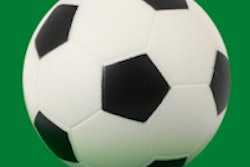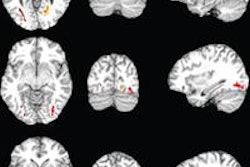CHICAGO - Too much "heading" a soccer ball could result in brain abnormalities similar to those found in traumatic brain injury patients, researchers from New York found in a study using diffusion-tensor MRI.
Players who head the ball with high frequency appear to suffer white-matter damage that resembles what is found in brain trauma injuries, said Dr. Michael Lipton, PhD, associate director of the Gruss Magnetic Resonance Research Center at Albert Einstein College of Medicine.
"What we've shown here is compelling evidence that there are brain changes that look like traumatic brain injury as a result of heading a soccer ball with high frequency," Lipton said at a press briefing at the RSNA 2011 conference.
He and colleagues used diffusion-tensor MRI to examine 38 amateur soccer players (5 women; average age, 31 years), and asked them to recall the frequency of heading in games and in practice during the previous 12 months.
Among those in the highest quartile of heading, there appeared to be a decrease in fractional anisotropy (FA) values compared to the players who headed the ball less frequently. The heading tries ranged from 0 to about 5,600 in the year, with 1,320 headings marking the highest quartile.
The researchers also searched for a frequency threshold level, above which white-matter damage could be detected. The threshold was approximately 1,000 to 1,500 heading attempts in the year; once players surpassed that level, Lipton and colleagues saw a significant decline in their FA in five identified brain regions.
"Abnormally low fractional anisotropy within white matter has been associated with cognitive impairment in patients with traumatic brain injury," Lipton said. "Given that soccer is the most popular sport worldwide -- including the U.S. -- and is played extensively by children, these are findings that should be taken into consideration in order to protect soccer players."
He added, however, that his study was not definitive. A large group of soccer players needs to be studied to determine if excessive heading is truly detrimental to players, according to Lipton. In his study, more medically apparent concussions occurred among players who were not in the top quartile of headers, he noted. That group had six concussions, compared with one among those in the top header group.
"These are changes in the brain that are similar to those we see with a concussion or traumatic brain injury," Lipton said. "I'm not advocating banning heading, but there may be a threshold level, which we defined, that indicates a safe range of heading."
Lipton explained that after heading the ball, patients have reported symptoms such as headache and feeling dazed or confused, and some studies have shown that cognitive performance may also be affected.
"He caught my attention with this study," said Dr. Max Wintermark, chief of neuroradiology at the University of Virginia and moderator of the press briefing. "I played soccer as a kid. My son is playing soccer now."
"These are still preliminary results," Wintermark noted. "There is a small number of participants in the study, so we have to be careful not to generalize findings that have been obtained in just a few patients. I think it is still worth study."
It might be helpful to study children who are just starting to learn to head the ball, he suggested. "But it is difficult to get children to hold still long enough -- it's even a problem in adults -- for a diffusion-tensor imaging study," he added. "To use MRI in children often requires sedation. Such a study would be interesting, but there are practical limitations."



.fFmgij6Hin.png?auto=compress%2Cformat&fit=crop&h=100&q=70&w=100)




.fFmgij6Hin.png?auto=compress%2Cformat&fit=crop&h=167&q=70&w=250)











